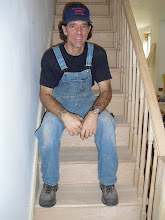I've been working in Philly for 30 years, since before the first cordless screw gun, and I've seen a few construction situations in my day. I wanted to put up a blog because the process itself is just that enjoyable and interesting, and I hope I can share it with you on an ongoing basis, rather than in the typical glossy magazine style of many contractor's web sites.
I have accomplished some very high end carpentry and also completed uncountable minor repairs. I've installed 5 piece crown mouldings in condos in the Barclay on Rittenhouse Square and I've climbed down into a septic system at a summer camp when I was 16, for some forgettable reason. I've been in charge of jobs worth 300 big G's and I've bought an abandoned house for 2,500 bucks that is now worth 100 times that amount because of my work. I've helped out a few times with squats. I've traded work with people who were low on funds, and I've volunteered with Habitat For Humanity (highly recommended experience for anyone). I've worked for poor people in the heart of so called bad neighborhoods and I've worked on a log cabin in W. Virginia. But also I've worked on many whole house renovations, a few of which lost money to someone who will gain tens of thousands of dollars of value because of my work! This is because the estimating part of the process can be way more difficult than the actual work. And yet, its a necessary part, the customer needs to know what they are getting into before hand. Carpentry can be a high cost expenditure, its not a can of soup you're buying. On that note of seriousness, I can also admit to having been a part of the changing landscape of Philadelphia's housing, i.e. the ill named "gentrification". However I will adamantly say that this topic is not a simple one, not easily broken down into right/wrong/rich/poor/white/black. And so, while asserting that decent housing should be a right for all people, I think we'll have to leave that particular discussion for another day (hope you don't mind).
So with some of these contradictions and varieties of experiences in mind I thought I'd create a little atmosphere relating to how I like to approach construction. It can seem daunting, there are often so many decisions to work through: design, price, cost vs quality, scheduling, site protection... etc etc. The main thing I've found is to create a process that works for both parties and to do that it takes communication. So, after all this, carpentry is really about communication, talking. Imagine that. The craftsperson works with her or his hands but what's important is to have relatively good communication with them. More talking is usually (but not always) better than less talking. And clear talking is even better than that. If possible.
I try to tell people that getting work done on your house is like learning a new skill set. Not necessarily easy but ultimately very rewarding. No one is going to become an interior decorator after one sitting with Fine Homebuilding. But those are good places to get ideas sometimes, I've enjoyed Better Homes and Gardens at the dentist's office more than once... But since most of us live in houses, its an area we would do well to learn about, we can develop our own style of getting it done. I advocate empowering you to learn what you need to learn to have the house you want to have.
So the main idea is to learn as you go and enjoy the process. Talk to as many people about your situation as you can. Trades people tend to be philosophical and full of advice, you can't be in this business without developing some attitudes about how to get the work done, - as well as stories about projects you've completed in the past. Meanwhile feel free to contact me about your project and I'll put my two cents in on it as well. Talk is cheap, its the work that counts.
In short, I could tell you that my goal is to get for you a great product for a decent price, and I think most of my past customers would agree that I accomplish this. In light of that, I've posted some photos of past projects so that you can see the variety of work I've completed. And I hope you will check back in to witness updates of current situations, as well as various commentaries. Hopefully a little carpenteerish philosophizing won't be too distracting from the main goal: happy houses for everyone (who cares to live in a house)!


 This is a job in Center City near 9th and Bainbridge. Tear the roof off of this one! and add balloon framing, solidify masonry walls and foundation and add 2 stories worth of windows and a built in roof deck. Nice! thanks to Kevin Rasmussen architect and Redmond Construction, for whom I worked at the time, for the opportunity to stretch my wings a little bit!
This is a job in Center City near 9th and Bainbridge. Tear the roof off of this one! and add balloon framing, solidify masonry walls and foundation and add 2 stories worth of windows and a built in roof deck. Nice! thanks to Kevin Rasmussen architect and Redmond Construction, for whom I worked at the time, for the opportunity to stretch my wings a little bit!



